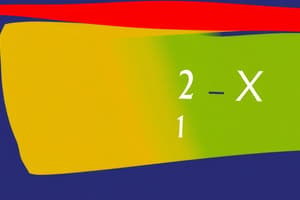Podcast
Questions and Answers
What does the exponent represent in a power?
What does the exponent represent in a power?
The number of times the base appears as a factor in the multiplication.
What is the result of any number to the exponent 1?
What is the result of any number to the exponent 1?
The number itself.
What is the value of any number (except 0) to the exponent 0?
What is the value of any number (except 0) to the exponent 0?
1
What is the value of $15 - (6 + 1) + 30 ÷ (3 imes 2)$ without using brackets?
What is the value of $15 - (6 + 1) + 30 ÷ (3 imes 2)$ without using brackets?
In the expression (8 - (5 + 1)) × 3, how do you evaluate it?
In the expression (8 - (5 + 1)) × 3, how do you evaluate it?
What is the result of $(-2)^3$?
What is the result of $(-2)^3$?
Explain the strategy for evaluating expressions with nested brackets.
Explain the strategy for evaluating expressions with nested brackets.
What rule governs the order of operations when dealing with brackets in an expression?
What rule governs the order of operations when dealing with brackets in an expression?
Evaluate the expression: 17 - 23 + 4 × 5.
Evaluate the expression: 17 - 23 + 4 × 5.
Solve the equation: 72 ÷ (3 × 2) - (10 + 1).
Solve the equation: 72 ÷ (3 × 2) - (10 + 1).
Evaluate the expression: (14 - 6) × ((30 + 5) ÷ 5).
Evaluate the expression: (14 - 6) × ((30 + 5) ÷ 5).
What are variables used for in math?
What are variables used for in math?
What is the importance of following the reverse BEDMAS order when undoing operations?
What is the importance of following the reverse BEDMAS order when undoing operations?
What is the rule that must always be followed when manipulating equations?
What is the rule that must always be followed when manipulating equations?
In algebra, why is it important to represent unknown quantities with variables in word problems?
In algebra, why is it important to represent unknown quantities with variables in word problems?
What is the 4-step process for solving word problems with algebra?
What is the 4-step process for solving word problems with algebra?
How can negative exponents and negative integers be involved in algebraic expressions?
How can negative exponents and negative integers be involved in algebraic expressions?
Explain the significance of using the two-step method to solve algebraic equations.
Explain the significance of using the two-step method to solve algebraic equations.
Flashcards are hidden until you start studying
Study Notes
Exponents
- The base is the number being multiplied repeatedly, and the exponent is the number of times it appears as a factor.
- Any number to the exponent 1 is equal to itself.
- Any number (except 0) to the exponent 0 is equal to 1.
Brackets
- Brackets are used to group parts of an expression into sub-expressions.
- We commonly use parentheses (), but can also use square brackets [] or curly brackets {}.
- Brackets are evaluated first in an expression, according to BEDMAS.
- Nested brackets can be used, and the inner-most brackets are evaluated first.
Solving Equations
- Variables are symbols used to represent unknown quantities.
- To solve an equation, we must undo operations in a reverse BEDMAS order.
- Whatever operation is done to one side of the equation must also be done to the other side.
- Important rules to remember:
- Addition and subtraction are opposite operations.
- Multiplication and division are opposite operations.
Solving Word Problems with Algebra
- To solve a word problem with algebra, follow these steps:
- Represent unknown quantities with variable(s).
- Use relationships given in the problem to set up equation(s) with the variable(s).
- Solve the equation(s) for the variable(s).
- Answer the question.
Examples and Exercises
- Evaluate the following expressions:
- 17 − 23 + 4 × 5 = ?
- (a) 72 ÷ (3 × 2) − (10 + 1) = ?
- ...
- Solve the following algebraic equations for x:
- (a) x − 4 = 5
- (e) 2x − 3 = 5
- ...
- Solve the word problem: In eight years from now, Sally will be four years younger than three times her current age. How old will she be in two years from now?
Studying That Suits You
Use AI to generate personalized quizzes and flashcards to suit your learning preferences.




